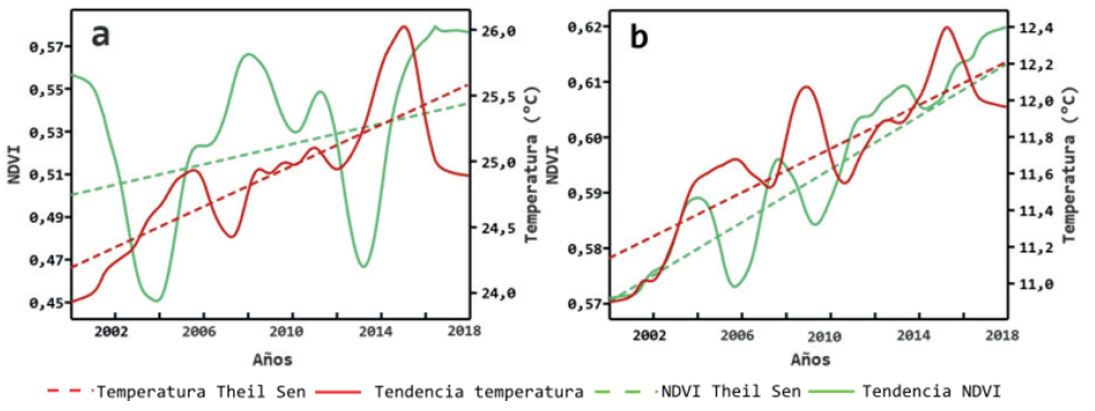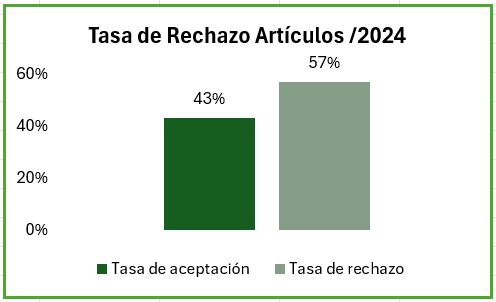Análisis de las tendencias del Índice de Vegetación de Diferencia Normalizado y variables climáticas en el Bosque deciduo de tierras bajas del Jama Zapotillo y Herbazal del Páramo de Loja, Ecuador
DOI:
https://doi.org/10.54753/blc.v15i1.2367Palabras clave:
tendencia, Mann-Kendall, Tau-Kendall, Theil Sen, ecosistemasResumen
A escala global el cambio climático es una amenaza que influye en el funcionamiento de los ecosistemas. En la región sur de Ecuador en sus ecosistemas se desconoce el los efectos de la variabilidad del clima local y regional. La presente investigación desarrolló como objetivo: Analizar las tendencias del índice de vegetación de diferencia normalizado-NDVI en relación a las tendencias de la temperatura y precipitación en el período 2001-2018 en el ecosistema Bosque deciduo de tierras bajas del Jama Zapotillo (BdTc01) y Herbazal del Páramo (HsSn02). Para lograr este propósito se obtuvo la tendencia de Loess de las series temporales de las variables climáticas de estudio, la prueba de Mann Kendall determino la presencia de tendencia, como complemento el coeficiente de Tau Kendall definió valores positivos para tendencias ascendentes. Finalmente, la prueba de Theil Sen calculó el incremento o disminución de la variable por unidad de tiempo. Los resultados indican en el periodo 2001-2018 la temperatura aumento 1,4 °C en BdTc01 y 1,08 °C en HsSn02. Mientras que las precipitaciones aumentaron en 17,26 mm en BdTc01 y 23,75 mm en HsSn02. Sin embargo, el NDVI fue similar mostrando incremento 0,04 en ambos ecosistemas de estudio. La investigación concluye que, en el período 2001-2018, el incremento de temperatura en el ecosistema del Bosque deciduo de tierras bajas del Jama Zapotillo y Herbazal del Páramo constituye una amenaza cuya magnitud se amplifica por anomalías regionales del clima que influyen en el clima local.Citas
Almar, R., Boucharel, J., Graffin, M., Abessolo, G. O., Thoumyre, G., Papa, F., Ranasinghe, R., Montano, J., Bergsma, E. W. J., Baba, M. W., & Jin, F. (2023). Influence of El Niño on the variability of global shoreline position. Nature Communications, 14(1). https://doi.org/10.1038/s41467-023-38742-9
Brun, P., Zimmermann, N. E., Hari, C., Pellissier, L., & Karger, D. N. (2022). Global climate-related predictors at kilometer resolution for the past and future. Earth System Science Data, 14(12), 5573-5603. https://doi.org/10.5194/essd-14-5573-2022
Calvin, K., Dasgupta, D., Krinner, G., Mukherji, A., Thorne, P. W., Trisos, C., Romero, J., Aldunce, P., Barrett, K., Blanco, G., Cheung, W. W., Connors, S., Denton, F., Diongue-Niang, A., Dodman, D., Garschagen, M., Geden, O., Hayward, B., Jones, C., . . . Ha, M. (2023). IPCC, 2023: Climate Change 2023: Synthesis Report. Contribution of Working Groups I, II and III to the Sixth Assessment Report of the Intergovernmental Panel on Climate Change [Core Writing Team, H. Lee and J. Romero (eds.)]. IPCC, Geneva, Switzerland. https://doi.org/10.59327/ipcc/ar6-9789291691647
Cambindo Altafuya, Ketty Alicia. Deforestación, cambio de uso del suelo y almacenamiento de carbono en el Parque Nacional Cotacachi Cayapas. Quito, 2024, 119 p. Tesis (Maestría en Cambio Climático, Sustentabilidad y Desarrollo). Universidad Andina Simón Bolívar, Sede Ecuador. Área de Ambiente y Sustentabilidad.
Cardinale, B. J., Matulich, K. L., Hooper, D. U., Byrnes, J. E., Duffy, E., Gamfeldt, L., Balvanera, P., O’Connor, M. I., & Gonzalez, A. (2011). The functional role of producer diversity in ecosystems. American Journal Of Botany, 98(3), 572-592. https://doi.org/10.3732/ajb.1000364
Cazalis, V., Princé, K., Mihoub, J., Kelly, J., Butchart, S. H. M., & Rodrigues, A. S. (2020). Effectiveness of protected areas in conserving tropical forest birds. Nature Communications, 11(1). https://doi.org/10.1038/s41467-020-18230-0
Dainese, M., Martin, E. A., Aizen, M. A., Albrecht, M., Bartomeus, I., Bommarco, R., Carvalheiro, L. G., Chaplin-Kramer, R., Gagic, V., Garibaldi, L. A., Ghazoul, J., Grab, H., Jonsson, M., Karp, D. S., Kennedy, C. M., Kleijn, D., Kremen, C., Landis, D. A., Letourneau, D. K., . . . Steffan-Dewenter, I. (2019). A global synthesis reveals biodiversity-mediated benefits for crop production. Science Advances, 5(10). https://doi.org/10.1126/sciadv.aax0121
Didan, K. (2021). MODIS/Terra Vegetation Indices 16-Day L3 Global 500m SIN Grid V061 [Data set]. NASA EOSDIS Land Processes DAAC. Accessed 2023-03-20 from https://doi.org/10.5067/MODIS/MOD13A1.061
Durán, S. M., Martin, R. E., Díaz, S., Maitner, B. S., Malhi, Y., Salinas, N., Shenkin, A., Silman, M. R., Wieczynski, D. J., Asner, G. P., Bentley, L. P., Savage, V. M., & Enquist, B. J. (2019). Informing trait-based ecology by assessing remotely sensed functional diversity across a broad tropical temperature gradient. Science Advances, 5(12). https://doi.org/10.1126/sciadv.aaw8114
Eklundh, L., Jönsson, P. (2015). TIMESAT: A Software Package for Time-Series Processing and Assessment of Vegetation Dynamics. In: Kuenzer, C., Dech, S., Wagner, W. (eds) Remote Sensing Time Series. Remote Sensing and Digital Image Processing, vol 22. Springer, Cham. https://doi.org/10.1007/978-3-319-15967-6_7
Fernando, W. D. (2012). Plants: An International Scientific Open Access Journal to Publish All Facets of Plants, Their Functions and Interactions with the Environment and Other Living Organisms. Plants, 1(1), 1-5. https://doi.org/10.3390/plants1010001
Ferrer-Sánchez, Y., Castillo, A. J. R., Plasencia-Vázquez, A. H., & Abasolo-Pacheco, F. (2024). Impacto del uso de suelo y la fragmentación del paisaje sobre la calidad del agua del río Teaone en Ecuador. Revista Internacional de Contaminación Ambiental, 40, 15-36. https://doi.org/10.20937/rica.54900
García, R., González, A., & Benavidez-Silva, C. (2023). Análisis espacio temporal del Índice de Vegetación de Diferencia Normalizado (NDVI) en el ecosistema bosque semideciduo piemontano del Catamayo Alamor. CEDAMAZ, 13(2), 140-147. https://doi.org/10.54753/cedamaz.v13i2.2053
Haines-Young, R., & Potschin, M. (2010). The links between biodiversity, ecosystem services and human well-being. Ecosystem Ecology: a new synthesis, 1, 110-139.
Hausmann, A., Slotow, R., Burns, J. K., & Di Minin, E. (2015). The ecosystem service of sense of place: benefits for human well-being and biodiversity conservation. Environmental Conservation, 43(2), 117-127. https://doi.org/10.1017/s0376892915000314
IPCC, 2023: Summary for Policymakers. In: Climate Change 2023: Synthesis Report. Contribution of Working Groups I, II and III to the Sixth Assessment Report of the Intergovernmental Panel on Climate Change [Core Writing Team, H. Lee and J. Romero (eds.)]. IPCC, Geneva, Switzerland, pp. 1-34, doi: 10.59327/IPCC/AR6-9789291691647.001
Calvin, K., Dasgupta, D., Krinner, G., Mukherji, A., Thorne, P. W., Trisos, C., Romero, J., Aldunce, P., Barrett, K., Blanco, G., Cheung, W. W., Connors, S., Denton, F., Diongue-Niang, A., Dodman, D., Garschagen, M., Geden, O., Hayward, B., Jones, C., . . . Ha, M. (2023). IPCC, 2023: Climate Change 2023: Synthesis Report. Contribution of Working Groups I, II and III to the Sixth Assessment Report of the Intergovernmental Panel on Climate Change [Core Writing Team, H. Lee and J. Romero (eds.)]. IPCC, Geneva, Switzerland. https://doi.org/10.59327/ipcc/ar6-9789291691647
Feron, S., Cordero, R. R., Damiani, A., MacDonell, S., Pizarro, J., Goubanova, K., Valenzuela, R., Wang, C., Rester, L., & Beaulieu, A. (2024). South America is becoming warmer, drier, and more flammable. Communications Earth & Environment, 5(1). https://doi.org/10.1038/s43247-024-01654-7
Forzieri, G., Dakos, V., Mcdowell, N. G., Ramdane, A., & Cescatti, A. (2022). Emerging signals of declining forest resilience under climate change. Nature, 608(7923), 534-539. https://doi.org/10.1038/s41586-022-04959-9
Higgins, S. I., Conradi, T., & Muhoko, E. (2023). Shifts in vegetation activity of terrestrial ecosystems attributable to climate trends. Nature Geoscience, 16(2), 147-153. https://doi.org/10.1038/s41561-022-01114-x
Karger, D. N., Schmatz, D. R., Dettling, G., & Zimmermann, N. E. (2020). High-resolution monthly precipitation and temperature time series from 2006 to 2100. Scientific Data, 7(1). https://doi.org/10.1038/s41597-020-00587-y
Karger, D. N., Wilson, A. M., Mahony, C., Zimmermann, N. E., & Jetz, W. (2021). Global daily 1 km land surface precipitation based on cloud cover-informed downscaling. Scientific Data, 8(1). https://doi.org/10.1038/s41597-021-01084-6
Kleemann, J., Zamora, C., Villacis-Chiluisa, A. B., Cuenca, P., Koo, H., Noh, J. K., Fürst, C., & Thiel, M. (2022). Deforestation in Continental Ecuador with a Focus on Protected Areas. Land, 11(2), 268. https://doi.org/10.3390/land11020268
Lausch, A., Selsam, P., Pause, M., & Bumberger, J. (2024). Monitoring vegetation- and geodiversity with remote sensing and traits. Philosophical Transactions Of The Royal Society A Mathematical Physical And Engineering Sciences, 382(2269). https://doi.org/10.1098/rsta.2023.0058
Li, J., & Prentice, I. C. (2024). Global patterns of plant functional traits and their relationships to climate. Communications Biology, 7(1). https://doi.org/10.1038/s42003-024-06777-3
Maita, J. (2015). Dinámica espacio temporal del Índice de vegetación Mejorado (EVI) en los Ecosistemas del Sur del Ecuador [Tesis de Maestría, Universidad del Azuay]. Dspace de la Universidad del Azuay. http://dspace.uazuay.edu.ec/handle/datos/4933
Ministerio del Ambiente del Ecuador. (2013). Sistema de Clasificación de Ecosistemas del Ecuador Continental. Subsecretaría de Patrimonio Natural, Quito.
Migliavacca, M., Musavi, T., Mahecha, M. D., Nelson, J. A., Knauer, J., Baldocchi, D. D., Perez-Priego, O., Christiansen, R., Peters, J., Anderson, K., Bahn, M., Black, T. A., Blanken, P. D., Bonal, D., Buchmann, N., Caldararu, S., Carrara, A., Carvalhais, N., Cescatti, A., . . . Reichstein, M. (2021). The three major axes of terrestrial ecosystem function. Nature, 598(7881), 468-472. https://doi.org/10.1038/s41586-021-03939-9
National Aeronautics and Space Administration's Earth Science Data Systems (ESDS) Program (https://search.earthdata.nasa.gov/search).
Nath, D., Nath, R., & Chen, W. (2024). Faster dieback of rainforests altering tropical carbon sinks under climate change. Npj Climate And Atmospheric Science, 7(1). https://doi.org/10.1038/s41612-024-00793-0
Pourrut, P. (1983). Los climas del Ecuador: fundamentos explicativos. Quito.
Psistaki, K., Tsantopoulos, G., & Paschalidou, A. K. (2024). An Overview of the Role of Forests in Climate Change Mitigation. Sustainability, 16(14), 6089. https://doi.org/10.3390/su16146089
QGIS Development Team. (2023). QGIS Geographic Information System (Version 3.32) [Software de geoinformación]. Open-Source Geospatial Foundation Project. https://qgis.org
Sangha, K. K., Gordon, I. J., & Costanza, R. (2022). Ecosystem Services and Human Wellbeing-Based Approaches Can Help Transform Our Economies. Frontiers In Ecology And Evolution, 10. https://doi.org/10.3389/fevo.2022.841215
Senf, C. (2022). Seeing the System from Above: The Use and Potential of Remote Sensing for Studying Ecosystem Dynamics. Ecosystems, 25(8), 1719-1737. https://doi.org/10.1007/s10021-022-00777-2
Udivia Zambrano, K.Y. (2020). Análisis de la dinámica espacio temporal del índice de vegetación de diferencia normalizada (ndvi) y su relación con patrones climáticos globales en el páramo ecuatorial entre el año 2001 y 2018 [Tesis de Maestría, Escuela Politécnica Nacional]. Repositorio digital– EPN. http://bibdigital.epn.edu.ec/handle/15000/21251
Villalba, D. J. S., Pazmiño, L. A. M., Del Corral Villarroel, V. H., Garófalo, M. F. M., Machado, D. A. Y., & Ulloa, C. o. P. (2024). Análisis del estado de la vegetación de una microcuenca amazónica mediante el NDVI. caso de estudio Microcuenca del Río Sandalias. Ciencia Latina Revista Científica Multidisciplinar, 8(4), 11003-11015. https://doi.org/10.37811/cl_rcm.v8i5.13236
World Meteorological Organization (2024). Estado del Clima en América Latina y el Caribe 2023. https://library.wmo.int/records/item/68895-el-estado-del-clima-en-america-latina-y-el-caribe-2023?offset=7
Yang, Y., Wang, S., Bai, X., Tan, Q., Li, Q., Wu, L., Tian, S., Hu, Z., Li, C., & Deng, Y. (2019). Factors Affecting Long-Term Trends in Global NDVI. Forests, 10(5), 372. https://doi.org/10.3390/f10050372
Yin, G., He, W., Liu, X., Xia, Y., & Zhang, H. (2024). Wetting or greening? Probing the global trends in Vegetation Condition Index (VCI). International Journal Of Applied Earth Observation And Geoinformation, 129, 103822. https://doi.org/10.1016/j.jag.2024.103822
Zeng, Y., Koh, L. P., & Wilcove, D. S. (2022). Gains in biodiversity conservation and ecosystem services from the expansion of the planet’s protected areas. Science Advances, 8(22). https://doi.org/10.1126/sciadv.abl9885

Publicado
Cómo citar
Número
Sección
Licencia
Derechos de autor 2025 Bosques Latitud Cero

Esta obra está bajo una licencia internacional Creative Commons Atribución-NoComercial-CompartirIgual 4.0.
Esta obra se publica bajo la licencia Creative Commons Atribución-NoComercial-CompartirIgual 4.0 Internacional (CC BY-NC-SA 4.0). Esto significa que los usuarios pueden copiar, distribuir y adaptar el contenido, siempre que se otorgue el crédito adecuado a los autores y a la revista. No se permite el uso comercial del material. Además, cualquier obra derivada debe distribuirse bajo la misma licencia. Esta licencia garantiza el acceso abierto al conocimiento, promoviendo la difusión y reutilización de los trabajos publicados sin fines de lucro, respetando la autoría y asegurando la libre circulación del contenido en términos equitativos.





























